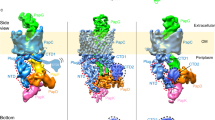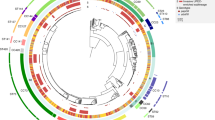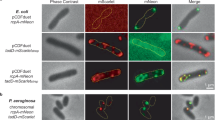Abstract
ESCHERICHIA coli is a frequent cause of several common bacterial infections in humans and animals, including urinary tract infections, bacteraemia and bacteria-related diarrhoea and is also the main cause of neonatal meningitis1. Microbial attachment to surfaces is a key event in colonization and infection and results mainly from a stereochemical fit between microbial adhesins and complementary receptors on host cells. Bacterial adhesins required for extracellular colonization by Gram-negative bacteria are often minor components of heteropolymeric fibres called pili which must be oriented in an accessible manner in these structures to be able to bind to specific receptor architectures. P pili mediate the binding of uropathogenic E. coli to a digalactoside receptor determinant present in the urinary tract epithelium. We report here that the adhesin is a component of distinct fibrillar structures present at the tips of the pili. These virulence-associated tip fibrillae are thin, flexible polymers composed mostly of repeating subunits of PapE that frequently terminate with theα-D-galactopyranosyl-(l-4)-β-D-galactopyranose or Galα(l-4)Gal binding PapG adhesin.
This is a preview of subscription content, access via your institution
Access options
Subscribe to this journal
Receive 51 print issues and online access
$199.00 per year
only $3.90 per issue
Buy this article
- Purchase on SpringerLink
- Instant access to full article PDF
Prices may be subject to local taxes which are calculated during checkout
Similar content being viewed by others
References
Hultgren, S. J., Abraham, S. N. & Normark, S. A. Rev. Microbiol. 45, 383–415 (1991).
Hultgren, S. & Normark, S. Curr. Opinions Genet. Dev. 1, 313–318 (1991).
Baga, M. et al. J. Bact 157, 330–333 (1984).
Lindberg, F., Lund, B., Johansson, L. & Normark, S. Nature 328, 84–87 (1987).
Hultgren, S. J. et al. Proc. natn. Acad. Sci. U.S.A. 86, 4357–4361 (1989).
Lindberg, F., Tennent, J. M., Hultgren, S. J., Lund, B. & Normark, S. J. Bact. 171, 6052–6058 (1989).
Kuehn, M. J., Normark, S. & Hultgren, S. Proc. natn. Acad. Sci. U.S.A. 88, 10586–10590 (1991).
Norgren, M., Baga, M., Tennent, J. M. & Normark, S. Molec. Microbiol. 1, 169–178 (1987).
Lindberg, F., Lund, B. & Normark, S. EMBO J. 3, 1167–1173 (1984).
Lindberg, F. thesis, Umea Univ. (1987).
De Graaf, F. K. & Mooi, F. R. Adv. microb. Pbysiol. 28, 65–143 (1986).
Brinton, C. C. Trans N.Y. Acad. Sci. 27, 1003–1054 (1965).
De Graaf, F. K., Klemm, P. & Gaastra, W. Infect. Immun. 33, 877–883 (1981).
Roosendaal, B., Gaastra, W. & De Graaf, F. K. FEMS Microbiol. Lett. 22, 253–258 (1984).
Jacobs, A. A. C., Venema, J., Leeven, J., Van Pelt-Heerschap, H. & De Graaf, F. K. J. Bact. 169, 735–741 (1987).
Riede, I., Drexler, K., Schwarz, H. & Henning, U. J. molec. Biol. 194, 23–30 (1987).
Ward, S. et al. J. molec. Biol. 54, 15–31 (1970).
Westerlund, B. et al. Molec. Microbiol. 5, 2965–2975 (1991).
Hull, R. A., Gill, R. E., Hsu, P., Minshaw, B. H. & Falkow, S. Infect Immun. 33, 933–938 (1981).
Furste, J. P. et al. Gene 48, 119–131 (1986).
Heuser, J. J. Cell Biol. 108, 401–411 (1989).
Heuser, J. J. Electron Microsc. Techq. 13, 244–263 (1989).
Lindberg, F., Lund, B. & Normark, S. Proc. natn. Acad. Sci. U.S.A. 83, 1891–1895 (1986).
Harlow, E. & Lane, D. Antibodies: A Laboratory Manual, 310 (Cold Spring Harbor Laboratory Press, New York, 1988).
Hoschutzky, H., Lottspeich, F. & Jann, K. Infect. Immun. 57, 76–81 (1989).
Baga, M., Norgren, M. & Normark, S. Cell 49, 241–251 (1987).
Holmgren, A. & Branden, C.-I. Nature 342, 248–256 (1989).
Holmgren, A., Kuehn, M. J., Branden, C.-I. & Hultgren, S. EMBO J. (in the press).
Author information
Authors and Affiliations
Rights and permissions
About this article
Cite this article
Kuehn, M., Heuser, J., Normark, S. et al. P pili in uropathogenic E. coli are composite fibres with distinct fibrillar adhesive tips. Nature 356, 252–255 (1992). https://doi.org/10.1038/356252a0
Received:
Accepted:
Issue date:
DOI: https://doi.org/10.1038/356252a0
This article is cited by
-
Effective assembly of fimbriae in Escherichia coli depends on the translocation assembly module nanomachine
Nature Microbiology (2016)
-
Inquisition of Microcystis aeruginosa and Synechocystis nanowires: characterization and modelling
Antonie van Leeuwenhoek (2015)
-
Impairment of the biomechanical compliance of P pili: a novel means of inhibiting uropathogenic bacterial infections?
European Biophysics Journal (2012)
-
Second Order Rate Constants of Donor-Strand Exchange Reveal Individual Amino Acid Residues Important in Determining the Subunit Specificity of Pilus Biogenesis
Journal of the American Society for Mass Spectrometry (2011)
-
Prevention of bacterial adhesion
Applied Microbiology and Biotechnology (2010)



